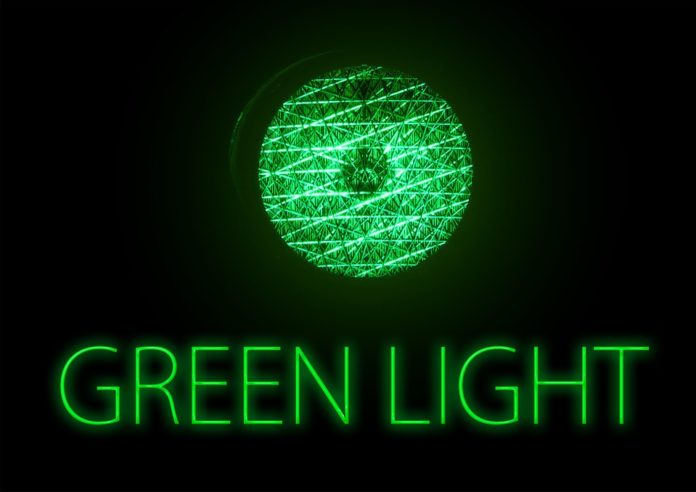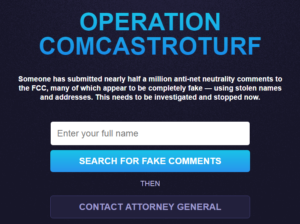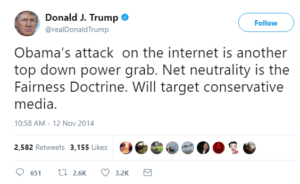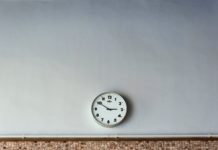
If you’ve been online even once over the past few weeks, chances are you’ve heard something about net neutrality and Ajit Pai, the former-Verizon-exec-turned-head-of-the-FCC, who is trying to dismantle it.
Net neutrality keeps all internet sites, well, neutral; i.e. one site loads just as quickly as the next and no corporation is allowed to interfere for profit. Repealing net neutrality would allow internet service providers (ISPs, e.g. Comcast and Verizon) to push traffic towards some websites, slow down traffic to others, and even block access at whim.
Here’s a telling example:
Operation Comcastroturf
Pro-net neutrality non-profit Fight For The Future received a cease and desist order from Comcast’s lawyers, claiming Comcastroturf.com (a site that allows you to search and see if your name was used to file fake FCC comments) violates Comcast’s “valuable intellectual property.” This is, ironically, exactly why we need the protections Title II offers. Under the proposed reclassification, there would be nothing in place to stop an ISP (like Comcast) from censoring (i.e. throttling or even completely blocking your access to) sites that are critical of their corporate policies.
There were numerous reports of fake comments on the FCC’s site. On Bloomberg, for example:
There were roughly 450,000 comments calling for a rollback of the current rules posted between May 8 and May 11. Large segments of those contained identical language and were posted in alphabetical order based on commenters’ names.

To make it seem as though there is support from the public for the push to repeal net neutrality regulations.
Of which there isn’t: Tens of thousands of Americans wrote complaints to the FCC in 2014, crashing the site, to help spark the discussion and ultimately led to net neutrality regulations in the first place.
Comcast claims the site violates the Anticybersquatting Consumer Protection Act and infringes on Comcast’s trademarks. We do not, however, find Comcastroturf “confusingly similar” to Comcast – it is clearly used in a satirical way. The site makes no attempt to impersonate Comcast and acts as a watchdog to better protect the consumer (i.e., we the consumer).
Basically, a Fortune 500 company was trying to limit internet usage on a site that was calling them out for fraudulent acts; a site that was attempting to put (keep) the power in the hands of the people.
And simultaneously proving why net neutrality is so important.
Quick shot: Where we are and how we got here
Okay let’s back up. Let’s paint a picture of this net neutrality saga to better illustrate what we’re dealing with. We’ll start at (basically) the beginning.
2010
The story first starts way back in December of 2010, when the FCC first welcomed net neutrality rules and regulations:
Issuing what was called an “Open Internet Order,” which stated that ISPs must be honest and forthcoming about the services they provide, and are not allowed to block/slow down access to content on the internet, the FCC, under the Obama administration, set the first precedent for achieving net neutrality.
2015
Fast forward five years. On February 26, 2015, at the behest of then-chairman Tom Wheeler, the FCC approved a new set of net neutrality regulations designed to keep business interests away from open internet. The rules ultimately classified broadband internet service as a public utility, allowing the internet to operate pretty much the same way a phone line (landline) does.
Imagine trying to have a three-way call session in junior high if Susie’s line was throttled because her family couldn’t pay more. Wouldn’t happen.
2016
In 2016, the salty ISPs challenged the Obama and Wheeler net neutrality rules in a case that went all the way up to the U.S. appeals court. The rules remained in place, however, as the challenge was struck down.
The internet remained open.
Tom Wheeler had this to say: “Today’s ruling is a victory for consumers and innovators who deserve unfettered access to the entire web, and it ensures the internet remains a platform for unparalleled innovation, free expression and economic growth… After a decade of debate and legal battles, today’s ruling affirms the Commission’s ability to enforce the strongest possible internet protections – both on fixed and mobile networks – that will ensure the internet remains open, now and in the future.”
The court’s ruling also helped support regulations requiring broadband internet to be equally accessible to all consumers, and prevented ISPs from charging more for faster downloading speeds.
But when Donald Trump was elected president on November 8…
Well, simply put, everything changed.
Donald Trump was always against net neutrality, as evidenced by tweets starting starting in 2014:

The president, once elected, then selected known anti-net neutrality advocate Jeffrey Eisenach for his transition team. Eisenach’s role? Develop strategy on telecommunications and technology.
2017
And this brings us to the aforementioned Ajit Pai. If Trump is the net neutrality super villain in this saga, Ajit Pai is his ultimate weapon.
Republican Pai, who was already FCC commissioner before being appointed Chairman by Trump on January 23, was a longtime member of Verizon’s general counsel before that.
Pai’s thoughts on net neutrality? A “heavy-handed” and “unnecessary” regulation.
And it didn’t take long for him to call for a repeal of the Obama-era net neutrality rules classifying internet as a public utility. Which, whether coincidentally or not (it’s not), help out his former Verizon employers quite a bit.
And the Senate wasted no time in overturning Obama’s Consumer Protections, on March 23.
From there, things started to move very quickly. This past spring, congress sent the White House a piece of legislation that removes the privacy measures, set up by the FCC, that kept your internet usage data (where you go, who you go there with, the sites and apps you use the most…) private from ISPs who would profit from selling it to advertisers and whoever else.
Basically, open season on all of your online browsing data and information; the first concrete indication businesses will be allowed, by the FCC, to generate profit from internet users in previously illegal ways.
Less than a month later, Chairman Pai announced his plan to overturn another of Obama’s net neutrality regulations; announced his intentions to dismantle the utility-like oversight of broadband internet providers. The FCC chairman released his proposed regulation in full , detailing the plan for ISPs to require people to pay for access to certain websites, the very next day.
“Pay to play” has never been a more apt description:
This means, ultimately, that providers can pick and choose which sites you visit; can give access to some and limit others, require unequal payment rates, and completely limit/take away the internet as we know it today.
And less than a month after that, the FCC voted to review Pai’s proposed dismantling of net neutrality; what he called “Restoring Internet Freedom.”
Freedom, however, is a subjective term. In this case? Freedom means allowing ISPs the freedom to control internet access in whatever ways they want.
And the millions of consumers who use their internet services, many of which don’t even have an option to choose an internet service provider (many people in many regions only have access to one) to no longer have any freedom in choosing the websites they visit.
Only the websites that ISPs want; those who have paid the most.
It also takes away the general freedom to start a business online, as small business sites won’t load like the larger competition who have paid to have their sites in an internet speed “fast lane,” i.e. the friends and partners of Comcast and Verizon, et al.
The official vote, the one that will kill net neutrality completely, is set for December 14.
Okay, so… what now?
Well, net neutrality advocates, i.e. tech stars like Netflix, Reddit, and Porn Hub, civil liberties activists like the ACLU, and every day internet users like you and me, came together to unite against Pai and the pending repeal of net neutrality regulations last July 12.
Called the Net Neutrality Day of Action, millions of comments were posted on the FCC system and hundreds of thousands signed petitions, leading up to many, many protests planned before the vote.
Want to know more about that? Go here: www.fightforthefuture.org
And make your voice heard and leave your own comment on the FCC proposals board, and go here for an easy way to let your representatives know that you like your internet the way it is.
Zachary Taylor Keple contributed to this article.
















